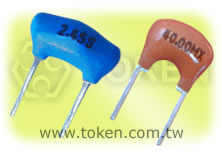Washable Epoxy Coated Ceramic Resonators 1.79 ~ 60.00 MHz (ZTA)
Washable Epoxy Coated MHz Ceramic Resonators (ZTA) Introduction
Token (ZTA) washable epoxy coated ceramic resonator is compatible to Murata resonator CSA.
Token resonators MHz (ZTA) series cover the frequency range of 1.79 MHz to 60.00 MHz with an initial frequency tolerance fo±0.5%, stability ±0.3% at operating temperature -20°C ~ +80°C, and aging tolerance ±0.3%. The tight tolerance frees the design engineers from having to use Quartz Crystals higher cost components and still achieve desired performance and reliability targets.
Tolerance is the main key characteristics to evaluate for a resonator. The total tolerance is the addition of the initial tolerance, temperature tolerance and aging tolerance. Tighter tolerances are possible through design advancements, material refinement and manufacturing techniques. Token's design and material improve the temperature and aging characteristics of the resonator. Token's manufacturing ability sort to tighter initial tolerances.
Token (ZTA) resonators implement the mechanical resonance of piezoelectric ceramics, that result in different vibration behaviors (modes) depending on the resonance frequency. Token (ZTA) series design utilizes this ceramic substrate by applying two metal electrodes evenly placed on both sides of the substrate. When voltage is applied, vibration of the ceramic substrate occurs between the electrodes. The thickness of the ceramic substrate determines the resonant frequency of the resonator.
The (ZTA) series conform to the RoHS directive. Custom parts are available on request. Token will also produce devices outside these specifications to meet specific customer requirements, please contact our sales for more information.
Download complete datasheet Washable Epoxy Coated MHz Ceramic Resonators (ZTA) PDF.
- All (ZTA) are epoxy coated and completely washable.
- Resistant to damage from impact and vibration.
- Tape and reel package are both available.
- Excellent temperature stability (±0.3%).
- Low cost.
Dimensions (ZTA)
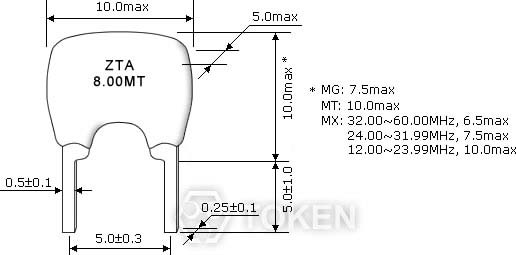 (ZTA8.00MT) Dimensions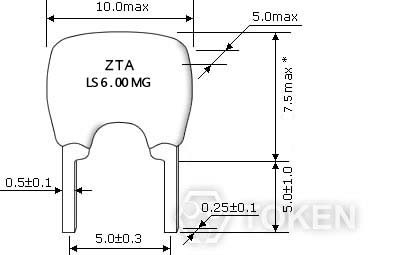 (ZTALS6.00MG) Dimensions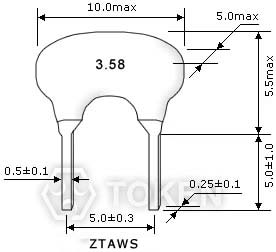 (ZTAWS) Dimensions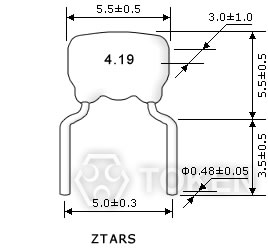 (ZTARS) Dimensions |
Technical Characteristics (ZTA)
| Part Number |
Frequency Range (MHz) |
Frequency Accuracy (at 25°C) (%) |
Stability in Temperature (-20°C ~ +80°C) (%) |
Operating Temperature (°C) |
Aging For Ten Years (%) |
| ZTA***MG | 1.79 ~ 6.00 | ± 0.5 | ± 0.3 | -20 ~ +80 | ± 0.3 |
| ZTAWS***MG | 1.79 ~ 6.00 | ± 0.5 | ± 0.3 | -20 ~ +80 | ± 0.3 |
| ZTALS***MG | 3.00 ~ 8.00 | ± 0.5 | ± 0.3 | -20 ~ +80 | ± 0.3 |
| ZTARS***MG | 3.00 ~ 10.00 | ± 0.5 | ± 0.3 | -20 ~ +80 | ± 0.3 |
| ZTA***MT | 6.00 ~ 13.00 | ± 0.5 | ± 0.3 | -20 ~ +80 | ± 0.3 |
| ZTA***MX | 12.00 ~ 60.00 | ± 0.5 | ± 0.3 | -20 ~ +80 | ± 0.3 |
Understanding Oscillation Circuit for MOS IC (ZTA)
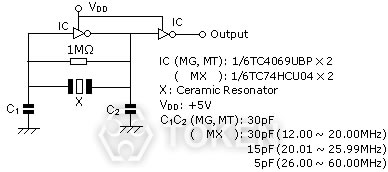
MHz Resonator (ZTA) Test Circuit for MOS IC
Loading Capacitor (C1 & C2)
The stability of the oscillation circuit is mainly determined by the C1 & C2 values. If the load capacitance is too small, unstable oscillation will occur because of oscillation waveform distortion. If too high, a stop in oscillation can be expected. When comparing the same IC, oscillation circuits with lower frequencies require higher capacitance.
Feedback Resistor (R = 1MΩ):
A Feedback Resistor is used to determine the oscillation circuit bias. The feedback resistance will contribute to instability if it is too large by reducing feedback. Conversely, if it is too small, increases in current will be realized thereby reducing gain. Recent developments in IC design allows for the integration of the feedback resistor in many cases.
Bias resistor (Rb optional):
A Bias Resistor can be utilized in the Resonator Oscillation Circuit to change the bias point when a reduction in IC gain is required, or to suppress unstable oscillation. This may be especially considered when a 3 stage buffered IC, or TTL IC, is used. Token Engineers can help with the circuit design if needed.
Damping Resistor (Rd optional):
Abnormal harmonic oscillation can be suppressed using a dampening resistor. The dampening resistor and load capacitors work together as a low-pass filter to reduce gain in the MHz range of oscillation.
ZTA Resonator Optimum IC Evaluations
Tolerance is determined by the design of the resonator. However stability and correlation is determined by the IC evaluation. The microcontroller is evaluated with the ceramic resonators to determine the best possible circuit conditions to achieve stability and stable oscillation.
In addition, frequency correlation is measured to meet the tight initial frequency tolerance required. For the tight tolerance resonators the IC evaluation must be completed on the final circuit board layout. The final circuit boards provide the most accurate measurement of the frequency correlation.
This measurement will account for the effects of stray capacitance on the oscillation frequency. Once the correlation is determined the frequency of the resonator is adjusted to compensate for the correlation.
Order Codes (ZTA)
| ZTA8.00MT | P | |||||||
 |  | |||||||
|
|
|||||||
